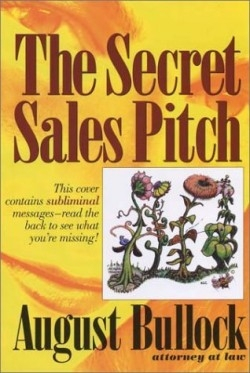The Secret Sales Pitch
An Overview of Subliminal Advertising
Advertisers deny it vehemently, but they use subliminal messages all the time. That’s the message of this challenging, profusely and provocatively illustrated book, documented by an attorney who has researched the subject for many years. While the author admits that the evidence is circumstantial, many of his illustrations convince beyond a doubt. How it is that society allows children to be swamped with hidden images, often pornographic and violent? The media depend on advertising for much of their revenue, so they won’t investigate it critically. Government supervision is limited, barring only those ads that use flash frames (images projected so quickly that they cannot be consciously detected, yet have been proven to influence viewers). There is no regulation of embedded images or airbrushing designed to create ambiguity, sexual provocation, even aggressive and self-destructive feelings.
Paradoxically, advertisers claim that they are naïve rather than conniving. “The public would feel threatened and defensive,” writes Bullock, “if advertisers admitted they were clever and manipulative. Advertising works best when we believe it is unpersuasive.”
The author gives the reader a shot at finding and interpreting the subliminals in pictures before he points them out. Sometimes Bullock goes overboard, finding penises, monsters, and death masks that require a magnifying glass and a fertile imagination to identify. Can such subtle “embeds” really affect the casual viewer? Could some of them simply be artists’ pranks?
There is much here that bolsters Freud’s concept of the unconscious, but the author’s reliance on Freudian interpretation of ambiguous messages leaves him open to criticism. He is right in saying that advertising itself is guided by good science-marketers have developed sophisticated techniques and can test results in large populations. Even a slight boost in sales will pay for extensive design and development costs. Marketers, he points out, have no scruples against promoting things we don’t need, or are harmful: faster cars, cigarettes, alcohol, excess food.
Bullock suggests a stunning remedy: let the government exercise eminent domain over research conducted more than forty years ago, forcing advertisers to make it public “because they acquired the data by experimenting on the public.” We would benefit from the unpublished information on subliminal perception and human behavior, he says, and focusing on the older research “would minimize the embarrassment of the firms involved.” Advertisers would fight that proposal, both above board and subliminally, no doubt. More power to Mr. Bullock! Perhaps this book will prompt some advertising insiders to come forward and tell it like it is.
Reviewed by
E. James Lieberman
Disclosure: This article is not an endorsement, but a review. The publisher of this book provided free copies of the book to have their book reviewed by a professional reviewer. No fee was paid by the publisher for this review. Foreword Reviews only recommends books that we love. Foreword Magazine, Inc. is disclosing this in accordance with the Federal Trade Commission’s 16 CFR, Part 255.

